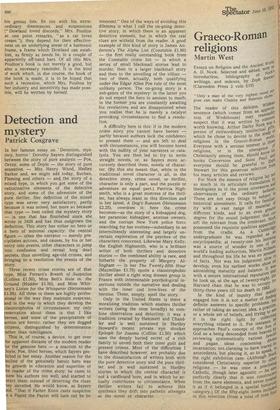Detection and mystery
Patrick Cos grave
In her famous essay on ' Detection, mystery, horror ' Dorothy Sayers distinguished between the story of pure analysis — Poe, Orczy, some of Doyle — the story of pure sensation — Mrs Henry Wood, Hedley Barker and, we might add today, Buchan, Fleming and others — and, the story of a mixed type, in which you got some of the ratiocinative elements of the detective story, and some of the adventure of the pure thriller. Her definition of the mixed type was never very satisfactory, partly because it was mixed; but more so because that type — best called the mystery story — is one that has flourished since she wrote in 1928 and has thus outgrown the definition. This story has either no hero or a hero of minimal capacity: the central figure — often the narrator — merely precipitates actions, and causes, by his or her entry into events, other characters to jump into confusion and reveal long " dead secrets, thus unveiling age-old crimes, and bringing to a resolution the events of the story.
• Three recent crime stories are of that type, Miss Ferrars's Breath of Suspicion (Collins E1.50), Miss Bell's Hole in the Ground (Hodder £1.50), and Miss Whitney's Listen for the Whisperer (Heinemann E1.95). All three or these are highly professional in the way they maintain suspense, and in the way in which they develop the claustrophobia of circumstance: my only reservation about them is that I like heroes, and none of the precipitators of action are heroic; rather they are dogged citizens, distinguished by determination rather than intelligence.
This is, of course, a device, to get over :he apparent distaste of the modern reader 'or the genuine hero — a reaction to the >oyle, Poe, Shiel heroes, which Sayers prelicted in her essay. Another reason for the lecline of the genuinely heroic hero was he growth in education and expertise of he reader of the crime story: he came to .now his authors too well, and started to etect them instead of detecting the clues ley unveiled. He would know, as Sayers aid, "that if Father Knox casts suspicion n a Papist the Papist will turn out be be innocent." One of the ways of avoiding this dilemma is what I call the on-going detective story, in which there is an apparent detective element, but in which the real clues are witheld from the reader. A good example of this kind of story is James Anderson's The Alpha List (Constable £1.80) — the first really outstanding book from the Constable crime list — in which a series of small blackmail stories lead to murder, then to a larger blackmail story and then to the unveiling of the villian — two of them, actually, both qualifying under the Edgar Allen Poe rule of the most unlikely person. The on-going story is a sub-genre of the mystery: in the latter you do not expect the hero to amount to much; in the former you are constantly awaiting his revelations and are disappointed when you realise that he is merely a catalyst provoking circumstances to find a resolution.
A difficulty here is this: if in the modern crime story you cannot have heroes partly because authors lack the confidence to present them — and are left to deal with circumstances, you will become bored with the nullity of your narrators or catalysts. You are then led to try to write straight novels, or, as Sayers more accurately described them, novels of character. (By this she meant that, while in the traditional novel character is all, in the detective story, crime novel, or thriller, character is only a part, and the puzzle or adventure an equal part.) Patricia Highsmith, who is a great mistress of the thriller, has always leant in this direction and in her latest, A Dog's Ransom (Heinemann £2.25), overdoes it: here the crime becomes—as the story of a kidnapped dog, her paranoiac kidnapper, anxious owners, and the corrupt New York police force searching for her evolves—subsidiary to an intermittently interesting and largely uncertain exploration of the psyches of the characters concerned. Likewise Mary Kelly, the English Highsmith, who is a brilliant writer of both thrillers and detective stories — the combined ability is rare, and hitherto the property of Margery Allingham — in her The Twenty-fifth Hour (Macmillan £1.75) spoils a claustrophobic thriller about a right wing dissent group in France with interminable psychological insertions outside the narrative and dealing with the inner and love-lives of the heroine. These, simply, spoil the story.
Only in the United States is there a moralising tradition which enables thriller writers (using the term broadly) to combine observation and detection: it was a tradition created by Hammett and Chandler and is well sustained in Hartley Howard's recent private eye shocker Epitaph for Joanna (Collins £1.50) which uses the deeply buried secret of a rich family to unveil both their inner guilt and present crimes. Most of the difficulties I have described however, are probably due to the dissatisfaction of writers both with the pure detective story and the pure thriller and is well sustained in Hartley stories in which the central character is not a cardboard bore, and in which he actually contributes to circumstance. When thriller writers fail to achieve this synthesis they drift into pathetic attempts at the novel of character.








































 Previous page
Previous page